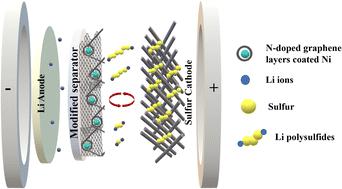Our official English website, www.x-mol.net, welcomes your
feedback! (Note: you will need to create a separate account there.)
Catalytic effects of Ni nanoparticles encapsulated in few-layer N-doped graphene and supported by N-doped graphitic carbon in Li–S batteries
RSC Advances ( IF 3.9 ) Pub Date : 2023-03-22 , DOI: 10.1039/d3ra00891f Nurzhan Baikalov 1 , Islam Rakhimbek 2 , Aishuak Konarov 1 , Almagul Mentbayeva 1 , Yongguang Zhang 3 , Zhumabay Bakenov 1, 2
RSC Advances ( IF 3.9 ) Pub Date : 2023-03-22 , DOI: 10.1039/d3ra00891f Nurzhan Baikalov 1 , Islam Rakhimbek 2 , Aishuak Konarov 1 , Almagul Mentbayeva 1 , Yongguang Zhang 3 , Zhumabay Bakenov 1, 2
Affiliation

|
Although lithium–sulfur batteries possess the highest theoretical capacity and lowest cost among all known rechargeable batteries, their commercialization is still hampered by the intrinsic disadvantages of low conductivity of sulfur and polysulfide shuttle effect, which is most critical. Considerable research efforts have been dedicated to solving these difficulties for every part of Li–S batteries. Separator modification with metal electrocatalysts is a promising approach to overcome the major part of these disadvantages. This work focuses on the development of Ni nanoparticles encapsulated in a few-layer nitrogen-doped graphene supported by nitrogen-doped graphitic carbon (Ni@NGC) with different metal loadings as separator modifications. The effect of metal loading on the Li–S electrochemical reaction kinetics and performance of Li–S batteries was investigated. Controlling the Ni loading allowed for the modulation of the surface area-to-metal content ratio, which influenced the reaction kinetics and cycling performance of Li–S cells. Among the separators with different Ni loadings, the one with 9 wt% Ni exhibited the most efficient acceleration of the polysulfide redox reaction and minimized the polysulfide shuttling effect. Batteries with this separator retained 77.2% capacity after 200 cycles at 0.5C, with a high sulfur loading of ∼4.0 mg cm−2, while a bare separator showed 51.3% capacity retention after 200 cycles under the same conditions. This work reveals that there is a vast utility space for carbon-encapsulated Ni nanoparticles in electrochemical energy storage devices with optimal selection and rational design.
中文翻译:

包裹在少层 N 掺杂石墨烯中并由 N 掺杂石墨碳支撑的 Ni 纳米粒子在 Li-S 电池中的催化作用
尽管锂硫电池在所有已知可充电电池中具有最高的理论容量和最低的成本,但其商业化仍然受到硫电导率低和多硫化物穿梭效应的固有缺点的阻碍,这是最关键的。大量的研究工作致力于解决 Li-S 电池每个部分的这些困难。用金属电催化剂对隔膜进行改性是克服这些缺点的主要部分的有前途的方法。这项工作的重点是开发封装在由氮掺杂石墨碳 (Ni@NGC) 支持的几层氮掺杂石墨烯中的 Ni 纳米颗粒,其中金属负载量不同,作为隔膜改性。研究了金属负载量对 Li-S 电化学反应动力学和 Li-S 电池性能的影响。控制 Ni 负载量可以调节表面积与金属的含量比,从而影响 Li-S 电池的反应动力学和循环性能。在具有不同 Ni 载量的隔膜中,Ni 含量为 9 wt% 的隔膜表现出最有效的多硫化物氧化还原反应加速,并使多硫化物穿梭效应最小化。采用这种隔膜的电池在 0.5C 下循环 200 次后容量保持 77.2%,硫负载量高达 ~4.0 mg cm 含 9 wt% Ni 的催化剂表现出最有效的多硫化物氧化还原反应加速,并最大限度地减少了多硫化物穿梭效应。采用这种隔膜的电池在 0.5C 下循环 200 次后容量保持 77.2%,硫负载量高达 ~4.0 mg cm 含 9 wt% Ni 的催化剂表现出最有效的多硫化物氧化还原反应加速,并最大限度地减少了多硫化物穿梭效应。采用这种隔膜的电池在 0.5C 下循环 200 次后容量保持 77.2%,硫负载量高达 ~4.0 mg cm-2,而裸隔膜在相同条件下经过 200 次循环后显示出 51.3% 的容量保持率。这项工作表明,通过优化选择和合理设计,碳包覆镍纳米粒子在电化学储能装置中具有广阔的应用空间。
更新日期:2023-03-22
中文翻译:

包裹在少层 N 掺杂石墨烯中并由 N 掺杂石墨碳支撑的 Ni 纳米粒子在 Li-S 电池中的催化作用
尽管锂硫电池在所有已知可充电电池中具有最高的理论容量和最低的成本,但其商业化仍然受到硫电导率低和多硫化物穿梭效应的固有缺点的阻碍,这是最关键的。大量的研究工作致力于解决 Li-S 电池每个部分的这些困难。用金属电催化剂对隔膜进行改性是克服这些缺点的主要部分的有前途的方法。这项工作的重点是开发封装在由氮掺杂石墨碳 (Ni@NGC) 支持的几层氮掺杂石墨烯中的 Ni 纳米颗粒,其中金属负载量不同,作为隔膜改性。研究了金属负载量对 Li-S 电化学反应动力学和 Li-S 电池性能的影响。控制 Ni 负载量可以调节表面积与金属的含量比,从而影响 Li-S 电池的反应动力学和循环性能。在具有不同 Ni 载量的隔膜中,Ni 含量为 9 wt% 的隔膜表现出最有效的多硫化物氧化还原反应加速,并使多硫化物穿梭效应最小化。采用这种隔膜的电池在 0.5C 下循环 200 次后容量保持 77.2%,硫负载量高达 ~4.0 mg cm 含 9 wt% Ni 的催化剂表现出最有效的多硫化物氧化还原反应加速,并最大限度地减少了多硫化物穿梭效应。采用这种隔膜的电池在 0.5C 下循环 200 次后容量保持 77.2%,硫负载量高达 ~4.0 mg cm 含 9 wt% Ni 的催化剂表现出最有效的多硫化物氧化还原反应加速,并最大限度地减少了多硫化物穿梭效应。采用这种隔膜的电池在 0.5C 下循环 200 次后容量保持 77.2%,硫负载量高达 ~4.0 mg cm-2,而裸隔膜在相同条件下经过 200 次循环后显示出 51.3% 的容量保持率。这项工作表明,通过优化选择和合理设计,碳包覆镍纳米粒子在电化学储能装置中具有广阔的应用空间。





















































 京公网安备 11010802027423号
京公网安备 11010802027423号